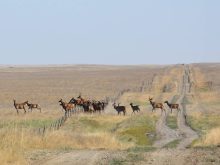SASKATOON – Only about five percent of eligible farmers asked for their money back from the research checkoff on Canadian Wheat Board grains last year.
That’s down from about 20 percent the year before, when the checkoff on sales of wheat and barley was introduced.
Lorence Peterson, executive director of the Western Grains Research Foundation, which administers the fund, said the increased participation likely means farmers are learning more about the checkoff. And he expects the refund rate will continue to drop.
“There wasn’t anything to show farmers value for their money invested last year, but there is this year,” he said in an interview after the foundation’s recent annual meeting.
Read Also

Bunge’s crop mix is changing
Bunge has predominantly been a soybean processing firm, but that’s about to change after the merger with Viterra with softseed processing and grain merchandising gaining ground.
Peterson expects once farmers see that wheat and barley they’re growing on their own farms have benefited from the checkoff, support for the program will become stronger. A detailed accounting of money and where it was awarded will be mailed to all farmers this spring.
The refundable checkoff, which became law in December 1994, provides for a deduction of 20 cents a tonne for wheat and 40 cents a tonne for barley sold to the wheat board. The money is taken off final payment cheques.
At the end of February, the foundation received a cheque from the Canadian Wheat Board for nearly $4 million, representing the amount of money deducted from the January 1996 final payment.
Peterson said 6,683 of approximately 124,000 CWB permit book holders asked for their money back, compared with 23,600 the year before.
Where the money goes
The $4 million raised in 1994-95 will be spent in the following way:
- $3 million for research projects ($2.4 million for wheat and $592,000 for barley.)
- $832,000 into reserve funds ($695,000 for wheat and $137,000 for barley.) The reserves now stand at $2.42 million for wheat and $562,000 for barley.
- $180,000 for administration ($144,000 for wheat and $36,000 for barley.)
At their meeting, the research foundation directors asked for legal advice on how much money they’re required to put into the reserve fund.
The legislation establishing the checkoff states 50 percent of the money raised must go into the reserve the first year and 25 percent “thereafter.”
The reserve is designed to ensure enough money is on hand to support ongoing research projects in years when check-off revenue is reduced because sales volumes are down or there is no final payment.
While the directors agreed a reserve is necessary, they don’t want to put in 25 percent every year and build up a reserve fund that’s out of proportion to the need. The consensus is the reserve funds should equal a year or two of check-off revenue.
Peterson said there is agreement the barley reserve should be greater than the wheat reserve, since barley is more subject to wide swings in production and sales.














